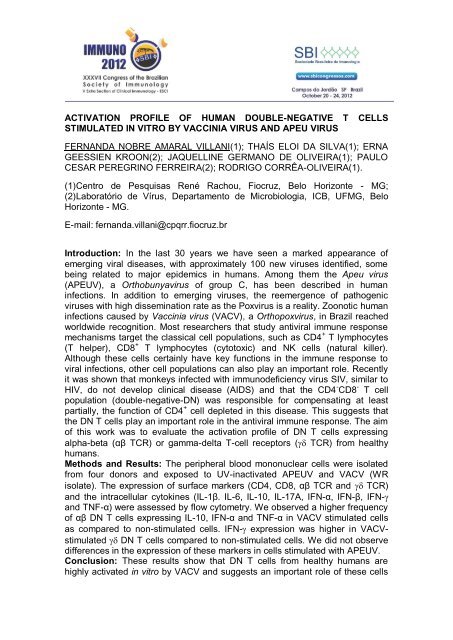immunology of infectious and parasitic diseases - XXXVII Congress ...
immunology of infectious and parasitic diseases - XXXVII Congress ...
immunology of infectious and parasitic diseases - XXXVII Congress ...
Create successful ePaper yourself
Turn your PDF publications into a flip-book with our unique Google optimized e-Paper software.
ACTIVATION PROFILE OF HUMAN DOUBLE-NEGATIVE T CELLS<br />
STIMULATED IN VITRO BY VACCINIA VIRUS AND APEU VIRUS<br />
FERNANDA NOBRE AMARAL VILLANI(1); THAÍS ELOI DA SILVA(1); ERNA<br />
GEESSIEN KROON(2); JAQUELLINE GERMANO DE OLIVEIRA(1); PAULO<br />
CESAR PEREGRINO FERREIRA(2); RODRIGO CORRÊA-OLIVEIRA(1).<br />
(1)Centro de Pesquisas René Rachou, Fiocruz, Belo Horizonte - MG;<br />
(2)Laboratório de Vírus, Departamento de Microbiologia, ICB, UFMG, Belo<br />
Horizonte - MG.<br />
E-mail: fern<strong>and</strong>a.villani@cpqrr.fiocruz.br<br />
Introduction: In the last 30 years we have seen a marked appearance <strong>of</strong><br />
emerging viral <strong>diseases</strong>, with approximately 100 new viruses identified, some<br />
being related to major epidemics in humans. Among them the Apeu virus<br />
(APEUV), a Orthobunyavirus <strong>of</strong> group C, has been described in human<br />
infections. In addition to emerging viruses, the reemergence <strong>of</strong> pathogenic<br />
viruses with high dissemination rate as the Poxvirus is a reality. Zoonotic human<br />
infections caused by Vaccinia virus (VACV), a Orthopoxvirus, in Brazil reached<br />
worldwide recognition. Most researchers that study antiviral immune response<br />
mechanisms target the classical cell populations, such as CD4 + T lymphocytes<br />
(T helper), CD8 + T lymphocytes (cytotoxic) <strong>and</strong> NK cells (natural killer).<br />
Although these cells certainly have key functions in the immune response to<br />
viral infections, other cell populations can also play an important role. Recently<br />
it was shown that monkeys infected with immunodeficiency virus SIV, similar to<br />
HIV, do not develop clinical disease (AIDS) <strong>and</strong> that the CD4 - CD8 - T cell<br />
population (double-negative-DN) was responsible for compensating at least<br />
partially, the function <strong>of</strong> CD4 + cell depleted in this disease. This suggests that<br />
the DN T cells play an important role in the antiviral immune response. The aim<br />
<strong>of</strong> this work was to evaluate the activation pr<strong>of</strong>ile <strong>of</strong> DN T cells expressing<br />
alpha-beta (αβ TCR) or gamma-delta T-cell receptors ( TCR) from healthy<br />
humans.<br />
Methods <strong>and</strong> Results: The peripheral blood mononuclear cells were isolated<br />
from four donors <strong>and</strong> exposed to UV-inactivated APEUV <strong>and</strong> VACV (WR<br />
isolate). The expression <strong>of</strong> surface markers (CD4, CD8, αβ TCR <strong>and</strong> TCR)<br />
<strong>and</strong> the intracellular cytokines (IL-1β. IL-6, IL-10, IL-17A, IFN-α, IFN-β, IFN-<br />
<strong>and</strong> TNF-α) were assessed by flow cytometry. We observed a higher frequency<br />
<strong>of</strong> αβ DN T cells expressing IL-10, IFN-α <strong>and</strong> TNF-α in VACV stimulated cells<br />
as compared to non-stimulated cells. IFN- expression was higher in VACVstimulated<br />
DN T cells compared to non-stimulated cells. We did not observe<br />
differences in the expression <strong>of</strong> these markers in cells stimulated with APEUV.<br />
Conclusion: These results show that DN T cells from healthy humans are<br />
highly activated in vitro by VACV <strong>and</strong> suggests an important role <strong>of</strong> these cells



